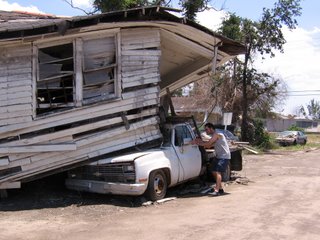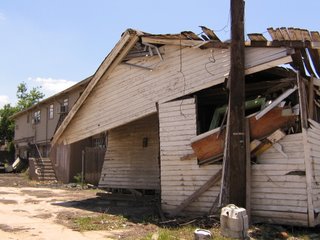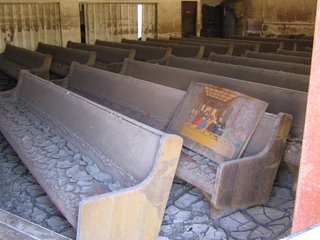
On the 2nd day, we drove around to get a closer look at the damage and talk to some locals. The devastation left one speechless. Block after block of damaged homes, many of them unliveable or totally destroyed. I was struck by the silence, the absence of human voices. Many of the residents left after the flooding and many have yet to return. Before Katrina, New Orleans had almost 480,000 residents. Now it's estimated to have maybe 155,000. According to a 2006 RAND report around 108,000 homes suffered severe flood damage. Severe flood damage is defined in the report as having been in 4 feet or more of water and having some kind of structural damage.
The house on the left was dragged off its foundations. You can see the front steps several feet away from the house.
The people we met that day were mostly friendly. They were surprised that we'd come all the way from New York to help with the cleanup. And the gratitude they expressed was heartfelt.
We talked with a gentleman who told us how, when the floodwaters were rising, rescuers had come by to take him and his family out of danger. But he told them to take his disabled, elderly neighbors instead. Why? Because he had
 a 2-story house and he could go up to the roof as the waters rose. Eventually he was picked up and taken to safety.
a 2-story house and he could go up to the roof as the waters rose. Eventually he was picked up and taken to safety.Another fellow, Joe, told us how the waters had risen so high he was able to pilot a boat over the chain link fence in front of his house. He showed us a broken front window, easily10 feet above the ground. At the height of the flood, a boat propeller had bumped against the glass and had smashed the glass.
When I asked him how he was doing he said, "Well, you just go on." We asked if we could say a
 prayer for him and he said, "Sure." One of our guys, Eddie, led the prayer for Joe's protection and for the Lord to provide for him and give him strength. As we left, Joe thanked us. We were happy just to be able to spend a few minutes with him and hear his story.
prayer for him and he said, "Sure." One of our guys, Eddie, led the prayer for Joe's protection and for the Lord to provide for him and give him strength. As we left, Joe thanked us. We were happy just to be able to spend a few minutes with him and hear his story. Further down we came across a damaged church. The mold smell was so bad we couldn't even peek inside the doorway without covering our noses. The brown marks on the back wall looks like some kind of water stain so you can see the flooding was pretty high.
Further down we came across a damaged church. The mold smell was so bad we couldn't even peek inside the doorway without covering our noses. The brown marks on the back wall looks like some kind of water stain so you can see the flooding was pretty high.Benches are covered with an inch thick layer of dried mud. Someone appears to have gone in and cleaned up a picture of the last supper of Jesus Christ and the disciples. Kinda poignant.

(Below is a panorama pic of a huge lot with damaged houses.)

